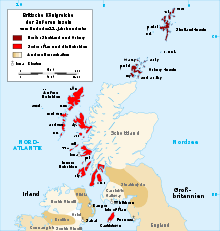King Orry's Grave
King Orry's Grave is the largest megalithic complex on the Isle of Man . The Clyde Tomb- type system is located on the A2 (road) not far from the east coast near the village of Laxey, in the garden of a private house. The complex made of colored sandstone has a semicircular forecourt 12 m in diameter and four meters deep in the east. The eastern gallery consists of three chambers that were intended for burials. At the western end is a separate box-like structure with a menhir , excavated in 1930 . It is unclear, since the middle section has not been preserved, whether it is part of the same system. This is supported by the statement that a long hill surrounded by curbs existed. During the excavation, only a burial and a bowl were found.
King Orry is the real King "Godred of Crovan" (Godred Whitehands). In the annals of Tigernach he is called "Gofraid Mac Meic Aralt" or "Godred Haraldsson". The Chronicles of Mann name him Godred, the son of Harald the Black of Ysland, which has been variously interpreted as Islay , Ireland, or Iceland, and make him a survivor of the defeat at the Battle of Stamford Bridge in 1066. He took over as Gottfried IV In 1079 the Vikings of Dublin took control of the "Kingdom of Man and the Isles". He died in 1095 and became the subject of a well-known Manx legend. Many monuments have been named in his honor, but there is no connection between the historical figure and the prehistoric remains.
In 1953 the eastern part of the site was the subject of an archaeological excavation. The western side remained privately owned until Manx National Heritage acquired the site.
literature
- Jack G. Scott: The Clyde Cairns of Scotland. In: Glyn Daniel, Poul Kjærum (Ed.): Megalithic graves and ritual. Papers presented at the III Atlantic Colloquium, Moesgård 1969 (= Jysk Arkaeologisk Selskabs skrifter. 11). Gyldendalske Boghandel (in comm.), Copenhagen 1973, ISBN 87-00-08861-7 , pp. 117–128.
- Jörg Lindenbeck: Investigations into late Neolithic and Early Bronze Age grave forms in south-west Scotland. In: Archaeological Information . Vol. 11, No. 2, 1988, pp. 228-232.
- Stephen Burrow: The Neolithic Culture of the Isle of Man: A Study of the Sites and Pottery. (British Archaeological Reports (BAR) British) Archaeopress, Oxford 1998, ISBN 0-86054-872-4 .
Web links
Coordinates: 54 ° 13 ′ 52.7 " N , 4 ° 24 ′ 5.6" W.

